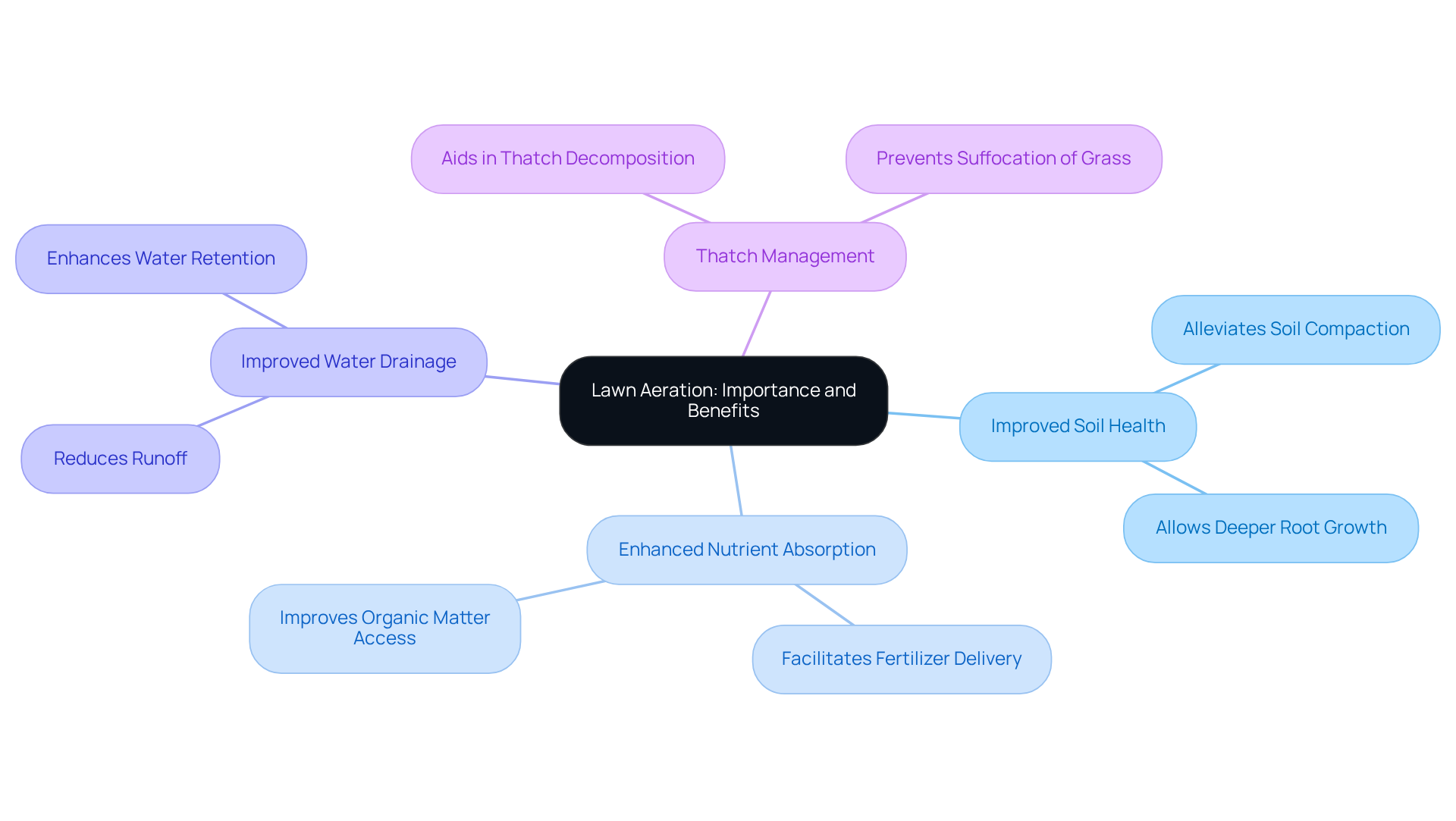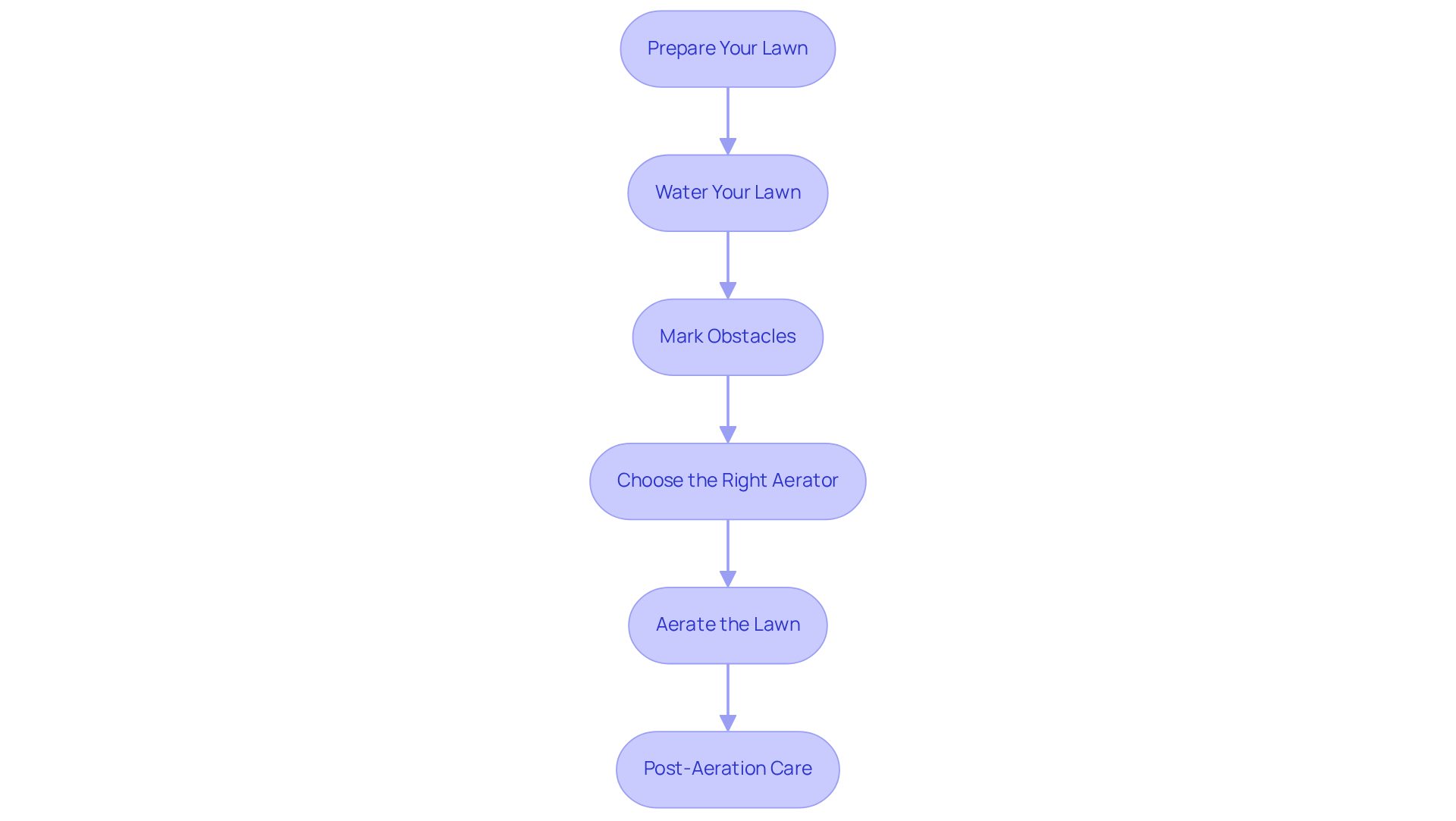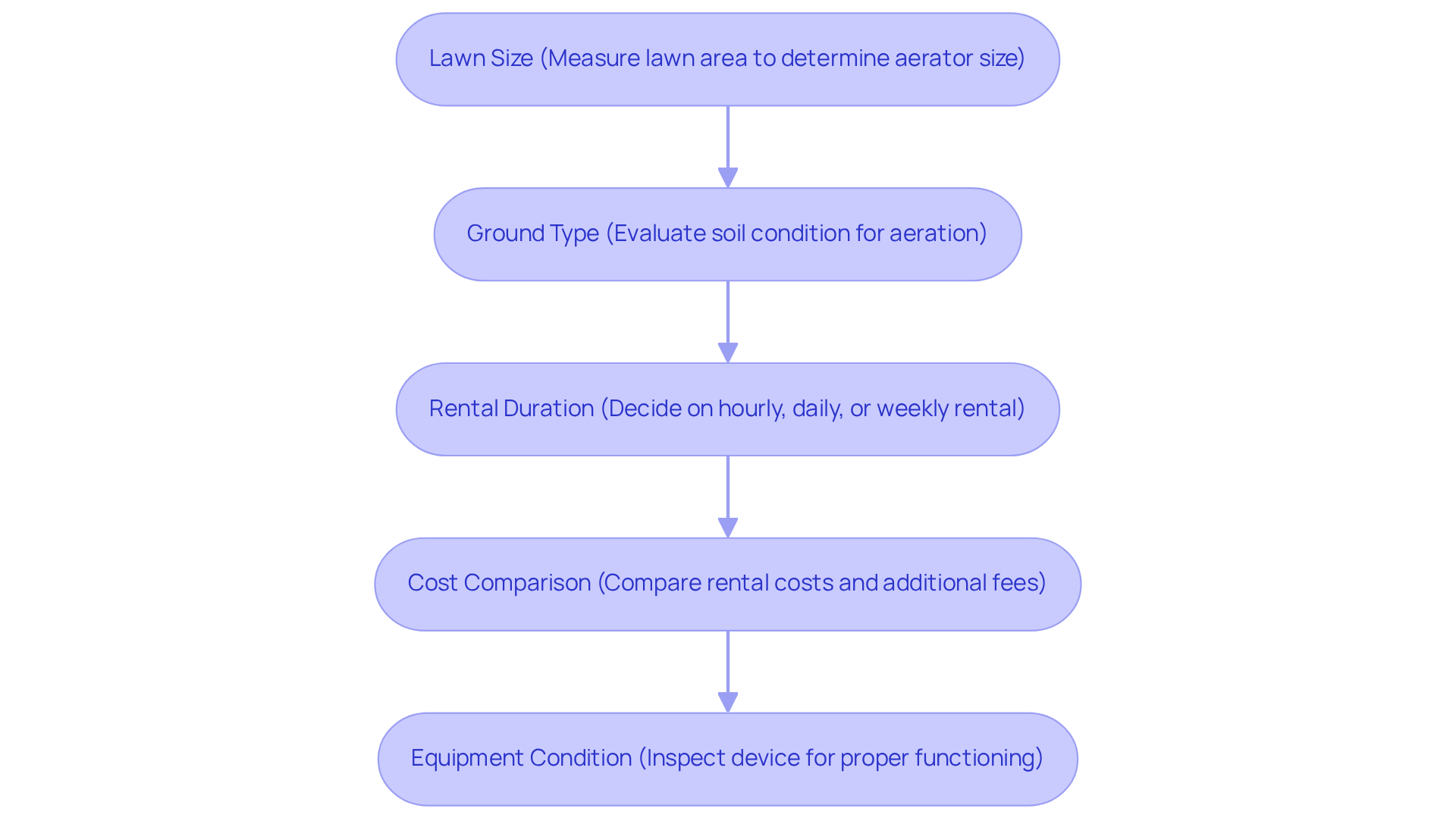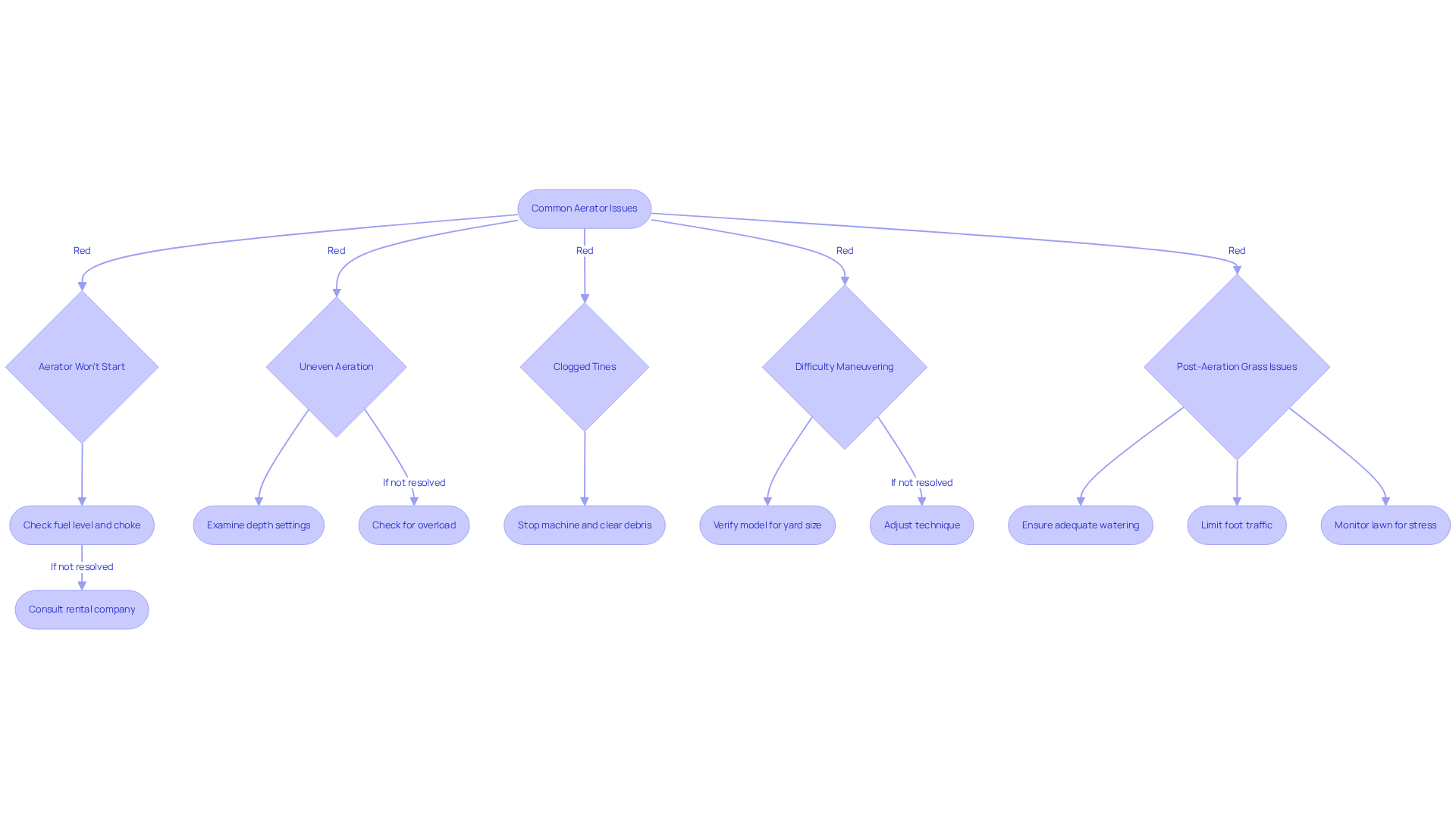Overview
The article delineates four essential steps for effectively renting an aerator for lawn care during a construction project. It emphasizes the importance of:
- Preparation
- Equipment selection
- Post-aeration maintenance
Detailed guidance is provided on:
- Assessing lawn size
- Ground type
- Rental duration
- Equipment condition
This ensures users can make informed decisions when selecting the right aerator. Additionally, it addresses common operational issues to optimize aeration results, reinforcing the reliability and quality of the equipment.
Key Highlights:
- Lawn aeration creates openings in the soil, allowing air, water, and nutrients to reach grass roots.
- Key benefits of aeration include improved soil health, enhanced nutrient absorption, better water drainage, and effective thatch management.
- To aerate effectively, mow grass to 2-3 inches, water the lawn beforehand, mark obstacles, and use a core aerator.
- Post-aeration care involves leaving soil plugs on the grass to decompose and watering the lawn to promote recovery.
- When renting an aerator, consider lawn size, ground type, rental duration, cost comparisons, and equipment condition.
- Common rental issues include starting problems, uneven aeration, clogged tines, manoeuvrability challenges, and post-aeration grass damage, each with specific troubleshooting steps.
Introduction
Lawn aeration is not merely a chore; it is an essential practice capable of transforming a struggling yard into a lush, vibrant oasis. By employing the right techniques, homeowners can unlock a multitude of benefits, such as:
- improved soil health
- enhanced nutrient absorption
- superior water drainage
However, the process of renting an aerator and executing effective aeration can present challenges that may leave many feeling overwhelmed. To ensure a successful aeration experience and to avoid common pitfalls, it is crucial to understand the essential steps involved.
Understand Lawn Aeration: Importance and Benefits
Lawn perforation serves as a crucial method for creating openings in the ground, enabling air, water, and nutrients to reach the grass roots effectively. This practice is vital for maintaining a healthy lawn, especially in areas experiencing significant foot traffic or soil compaction. The benefits of aeration are substantial:
- Improved Soil Health: Aeration alleviates soil compaction, allowing roots to grow deeper and access essential nutrients.
- Enhanced Nutrient Absorption: By creating holes in the soil, aeration facilitates the effective delivery of fertilizers and organic matter to the root zone.
- Improved Water Drainage: Aerated grass areas experience less runoff and enhanced water retention, which is critical during dry periods.
- Thatch Management: Aeration aids in decomposing thatch, the layer of dead grass and roots that can suffocate your yard.
Understanding these advantages empowers you to take the necessary actions to rent an aerator lawn and aerate your grass efficiently.

Follow the Steps to Aerate Your Lawn Effectively
To aerate your lawn effectively, follow these essential steps:
-
Prepare Your Lawn: Begin by mowing your grass to a height of about 2-3 inches. This height facilitates easier penetration into the ground, ensuring optimal aeration results.
-
Water your lawn thoroughly a day or two before the aeration process. The ground should be damp but not waterlogged, as this moisture assists the aeration device in functioning more efficiently.
-
Mark Obstacles: Identify and mark any underground utilities, sprinkler heads, or other barriers. This precaution will help you avoid damaging them during the soil treatment process.
-
Choose the Right Aerator: For optimal results, consider to rent aerator lawn, specifically a core aerator. This type of aerator removes plugs of earth rather than simply poking holes, which enhances the aeration process.
-
Aerate the Lawn: Start at one corner of your yard and move in straight lines, overlapping each pass slightly. Make several passes in various directions to ensure complete ventilation of the soil.
-
Post-Aeration Care: Leave the soil plugs on the grass to decompose and return vital nutrients to the soil. After aeration, water the grass again to assist in recovery and encourage robust growth.

Choose the Right Aerator Rental: Key Considerations
When you rent aerator lawn, it is crucial to consider several key factors to ensure you select the right equipment for your needs.
-
Lawn Size is the first consideration. Measure your lawn area to determine the appropriate size of the aerator. For larger lawns, a tow-behind device may be necessary, while smaller areas can be effectively managed with a walk-behind model. This distinction is vital for achieving optimal results.
-
Next, assess the Ground Type. Evaluate your ground condition carefully. If your soil is heavily compacted, a core tool is recommended for optimal aeration results. This choice will significantly enhance the health of your lawn.
-
Additionally, consider how long you need to rent the aerator lawn. Decide how long you will need the equipment, as most rental companies provide options for hourly, daily, or weekly rentals. Choosing the duration that best fits your project timeline is essential for efficient management of your resources.
-
Moreover, compare the costs to rent aerator lawn from different companies. Look for any additional fees, such as delivery or damage waivers, to ensure you stay within your budget. This diligence can prevent unexpected expenses and ensure a smooth rental experience.
-
Lastly, inspect the Equipment Condition before finalizing your rental. Ensure the device is in good working condition and that all parts function properly. This precaution will help you avoid issues during your rental period and guarantee reliable performance.

Troubleshoot Common Aerator Rental Issues
When you rent an aerator lawn device, you may encounter several common issues that can hinder your experience. Understanding how to troubleshoot these problems will ensure optimal performance and satisfaction when you rent aerator lawn.
-
Aerator Won't Start: First, check the fuel level and ensure the choke is set correctly. If the device still fails to start, it is advisable to consult the rental company for further assistance. This step is crucial to avoid unnecessary delays in your aeration process.
-
Uneven Aeration: Should you notice that the device is not creating uniform holes, it is essential to examine the depth settings. Additionally, ensure that the machine is not overloaded with weight, as this can affect its performance. Proper adjustments will enhance the effectiveness of your aeration efforts.
-
Clogged Tines: If you encounter clogged tines due to soil buildup, immediately stop the machine and clear any debris. Regularly checking for clogs during operation is vital to maintain optimal performance and ensure the aerator functions efficiently.
-
Difficulty Maneuvering: If maneuvering the aerator proves to be a challenge, verify that you are using the appropriate model for your yard size and terrain. Adjusting your technique can also significantly improve handling, making your aeration task more manageable.
-
Post-Aeration Grass Issues: After aeration, if your turf appears damaged, it is crucial to ensure adequate watering and to limit heavy foot traffic until the grass has had time to recover. Monitoring your lawn for signs of stress and adjusting your care routine accordingly will promote healthy regrowth and enhance the results of your aeration.

Conclusion
Renting a lawn aerator is an essential step in cultivating a healthy and vibrant lawn. Understanding the significance of aeration and following the outlined steps can greatly enhance soil health, nutrient absorption, and water drainage. This process not only revitalizes the grass but also sets the stage for long-term growth and resilience against environmental stressors.
This article offers a comprehensive guide that highlights the importance of lawn aeration, practical steps for effective aeration, key considerations when renting an aerator, and solutions for common issues that may arise during the rental process. Each section underscores the necessity of preparation, the right equipment, and post-aeration care, ensuring that readers are well-prepared to achieve optimal results.
Ultimately, dedicating time and effort to aerate a lawn can lead to a lush, green space that flourishes throughout the seasons. By taking the necessary steps to rent the appropriate aerator and promptly addressing any issues, homeowners can cultivate a healthy environment for their grass. Embracing these practices not only enhances the aesthetic appeal of a property but also contributes to a sustainable landscape that benefits both the homeowner and the ecosystem.
Frequently Asked Questions
What is lawn aeration?
Lawn aeration is the process of perforating the soil to create openings that allow air, water, and nutrients to reach the grass roots effectively.
Why is lawn aeration important?
Lawn aeration is important for maintaining a healthy lawn, particularly in areas with significant foot traffic or soil compaction.
What are the benefits of lawn aeration?
The benefits of lawn aeration include improved soil health, enhanced nutrient absorption, improved water drainage, and better thatch management.
How does aeration improve soil health?
Aeration alleviates soil compaction, allowing roots to grow deeper and access essential nutrients.
How does aeration enhance nutrient absorption?
By creating holes in the soil, aeration facilitates the effective delivery of fertilizers and organic matter to the root zone.
What effect does aeration have on water drainage?
Aerated grass areas experience less runoff and improved water retention, which is crucial during dry periods.
How does aeration help with thatch management?
Aeration aids in decomposing thatch, the layer of dead grass and roots that can suffocate your lawn.




